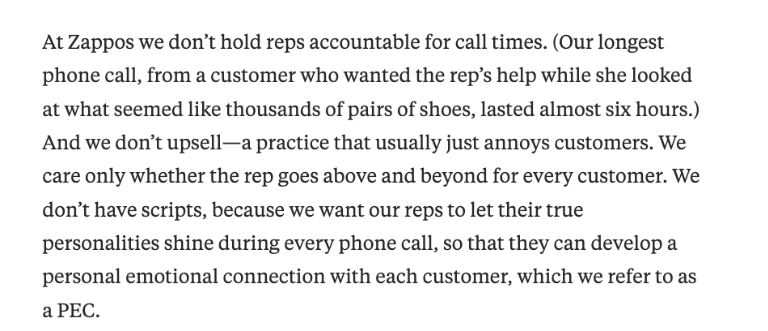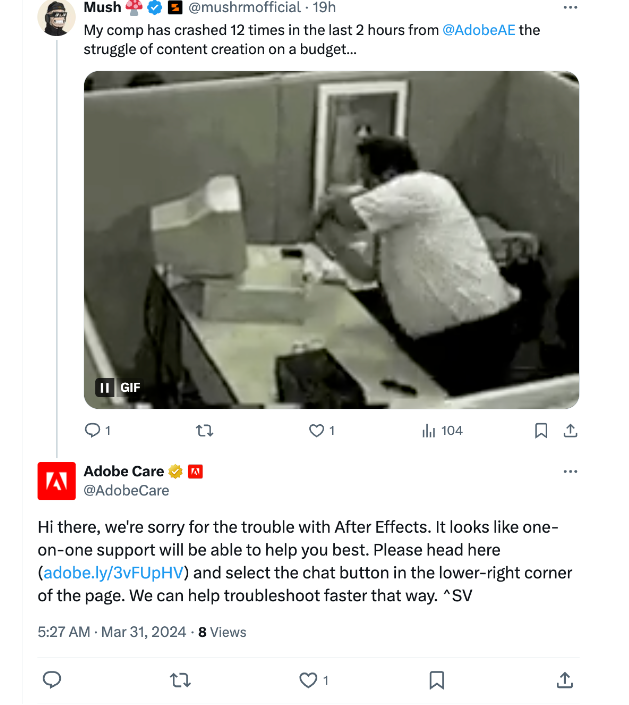How to Use Customer Service Empathy Statements: A Quick Guide

The main difference between poor and good customer service boils down to a single factor: empathy.
When customers are upset or frustrated, being empathetic changes how they feel about your brand. It shows you get where they’re coming from, calming them and making them more likely to give your company another chance.
The good news is that being empathetic isn’t that complicated.
To start, you can use customer service empathy statements to show customers you care. This lays the groundwork to help you better understand their concerns and proves you’re paying attention.
What is an empathy statement?
Empathy statements are words or phrases used in customer service interactions to communicate your understanding and validation of a customer’s feelings—essentially, to empathize with them.
Adding these statements to your customer service scripts is a great way to acknowledge the customer’s emotions, thereby building loyalty and improving customer satisfaction.
Ways to show empathy in customer service
Here are more empathetic call and chat support tips to build meaningful customer relationships:
Be approachable: Make your tone of voice, body language, and demeanor empathetic. And smile—a lot. This shows the customer you’re listening and keen to help.Active listening: Let the customer speak without interruption. Use verbal and non-verbal cues (think: nodding, paraphrasing their statements) to show you understand their concerns.Respond respectfully: Use positive and empathetic language during the conversation (“I’ll help you throughout the process to resolve your query”). Offer practical solutions or take genuine action to help.Validate their feelings: Allow angry and frustrated customers to vent and get it all out. Then validate their experiences, assuring them their issues are important. Even if you disagree with their perspective, don’t downplay their feelings.Take responsibility: Acknowledge mistakes and shortcomings on the company’s part, and apologize sincerely for the frustration or inconvenience caused. Take proactive steps to rectify the situation and stop similar issues from happening in the future.Why use empathy statements in customer service?
The simple answer is to show customers your company prioritizes their well-being over profits.
Here’s how customer service empathy statements make this happen:
Build rapport and establish trust
Trust is the foundation of long-term customer relationships, and empathetic agents earn the customers’ trust faster by making them feel heard and establishing positive sentiment. In turn, they become more willing to trust your intentions and accept support.
De-escalate tense situations
Customers expect prompt action from the company to address their concerns. Empathetic statements give them this reassurance and calm them, effectively de-escalating or diffusing potentially volatile situations.
This approach facilitates constructive dialogue and problem-solving, lowering the risks of negative publicity on social media platforms and customer churn.
Enhance customer satisfaction
89% of consumers prefer buying from brands that understand their needs and show care. Empathy statements are a solid step in meeting these expectations, helping you level with a customer’s emotions.
Customers feel valued and supported, even in challenging situations, which makes them more likely to leave the interaction feeling satisfied and positive about your brand. This approach can be particularly beneficial when you are developing a business plan or looking to start a business, as customer satisfaction is a key component of long-term success.
Create a positive customer service experience
Empathetic customer conversations pave the way for positive customer experiences, making customers feel valued and supported. What’s more, these positive experiences extend beyond individual interactions and shape a customer’s overall (positive) brand awareness and perceptions.
23 Essential empathy statements for every customer service interaction
Now that we’ve established why empathy is important, let’s review some key customer service empathy statements. Use the following phrases to convey you’re sympathetic to a customer’s issue:
When you want to acknowledge customer concerns
1. “I understand your frustration, (Customer Name).”
This statement acknowledges the customer’s frustration and validates their emotions.
2. “I appreciate you bringing it to our attention. Rest assured, I’ve made a note of your complaint and am looking into this right away.”
This phrase expresses gratitude and shows you’ve been listening actively to what they have to say.
3. “I’m sorry you’ve been experiencing this issue, (Customer Name).”
Apologizing is important for two reasons. Firstly, it recognizes the customer’s discomfort or inconvenience. Secondly, it shows you care for the customer’s brand experience.
4. “I can see why this is upsetting. We’ll work on resolving it together.”
This empathy statement validates and respects the customer’s emotions, and then promises a solution.
5. “I appreciate your patience as we work through this together.”
This is another great way to acknowledge customer concerns while asking them to be patient as you work on resolving them.
When you want to offer support and assistance
6. “Please allow me to assist you in this. “
The statement is respectful and offers direct support, showing your willingness to ease the customer’s challenges.
7. “We’re committed to making this right for you.”
Use this statement to reassure the customer of ongoing support and convey that your company is genuinely committed to helping them resolve their issue.
8. “I’m here to assist you until we find a solution.”
Similar to the above, this empathy phrase shows you want to make things right for the customer.
9. “Rest assured, we’ll work together to find a solution, (Customer Name).”
By emphasizing collaboration, this statement recognizes the customer as a partner in problem-solving and involves them in the resolution process.
10. “Please don’t hesitate to reach out if you need further assistance.”
This is a great way to end an interaction after you’ve helped the customer with an issue, assuring ongoing support.
When you want to express understanding
11. “I’ve experienced a similar situation before, and I understand where you’re coming from.”
Sharing personal experiences is a great way to show empathy. When you relate to their situation, the customer feels they’re not alone in their struggles.
12. “It sounds like you’re feeling (emotion), and I want to help you.”
This phrase states you understand the customer’s perspective and that you‘re willing to support them emotionally.
13. “I want you to know that we genuinely care about your experience.”
This is another effective statement to validate the customer’s feelings, show empathy, and acknowledge their experience.
When you want to apologize sincerely
14. “We’re sorry for the trouble you encountered, (Customer Name). Rest assured, we’re taking this seriously at (Company Name).”
This statement expresses empathy for the difficulties the customer has faced and acknowledges your company’s responsibility for addressing them.
15. “Firstly, I want to apologize for the inconvenience this has caused you.”
Use this to show you understand the impact of the issue on the customer and express regret for their frustrations.
16. “I’m genuinely sorry for the frustration you’re facing, (Customer Name).”
In addition to expressing genuine empathy, this phrase voices a sincere desire to alleviate the customer’s problem.
17. “I apologize to hear you’re going through this.”
Just like the previous statement, use this to empathize with the customer.
When you want to reassure customers
18. “Rest assured, I’m going to do everything I can to resolve this.”
This reassuring phrase gives the customer confidence their issue will be addressed and resolved promptly.
19. “Thank you for letting us know. We’ll work quickly to find a solution for you.“
Showing a sense of urgency in resolving issues is a crucial aspect of empathetic customer service. You recognize the importance of the customer’s time and ensure their needs are being prioritized.
20. “You’re a valued customer at (Company Name), and your satisfaction is my top priority.”
Use this customer service empathy statement to reassure the customer their well-being and satisfaction are important to you.
When you want to empathize with specific situations
21. “Billing errors are understandably stressful. We’ll get this sorted right away.”
Use this to acknowledge billing errors and reassure the customer the issue will be addressed on a priority.
22. “I know waiting for a resolution can be inconvenient. I’m here to assist you in any way I can.”
The statement works for two reasons. One, it acknowledges the customer’s wait empathetically. And two, it respectably offers support and assistance.
23. “I understand how frustrating dealing with technical issues can be. I thank you for your patience.”
This statement acknowledges the challenges associated with technical issues. Use it to show you understand the customer and that they’re not alone in that situation.
Real-world examples of prime customer service empathy statements
Here are a few real-life examples showing how customer service empathy statements work, each highlighting the crucial elements of good customer service:
Address the root cause
In December 2015, Airbnb faced accusations of racial profiling and discrimination. Instead of ignoring the problem, Airbnb took action: The CEO sent the following email to all clients, addressing the issue:
Apology email from Airbnb CEO to customers
Moreover, Airbnb implemented a new policy to combat discrimination and conducted an audit. It also launched an inclusion campaign to promote diversity and equality.
Actively listen
Zappos makes it a point to listen to its customers’ concerns and feedback actively. Reps engage in genuine conversations with customers, taking the time to understand their needs and preferences, whether it’s finding the right shoe size or resolving a shipping issue. Things like these helps companies grow and gain more customers.
Here’s how Founder Nick Swinmurn described his company’s empathetic customer service to Harvard Business Review:

Clipping from Harvard Business Review article interviewing Zappos founder.
Take ownership
Amazon is renowned for being a customer-centric organization, where reps are empowered to take ownership of customer problems. If a customer is dissatisfied with a purchase, Amazon staff members take responsibility for resolving the issue promptly, whether it’s offering a refund, exchange, or finding an alternative solution.

Twitter screenshot of Amazon answering a customer complaint.
Be flexible
Adobe is another great example of flexible and empathetic customer service. When users encounter issues, Adobe reps are quick to help. They guide users to articles in the help center or connect them with experts for 1:1 support.

Twitter screenshot of Adobe answering a customer complaint
Follow through
After a guest’s son left his beloved stuffed giraffe behind, Ritz-Carlton Hotels went above and beyond. Not only did the staff locate the toy, but they also sent a package containing the giraffe, along with goodies and a binder. This binder humorously documented the giraffe’s extended stay, acknowledging a little white lie the guest had told their son.
Takeaway thoughts
Here’s the thing: Customer decisions are often emotional rather than logical, making empathy a powerful tool to strengthen customer connections. Even if the perfect solution isn’t always possible, using empathy statements in customer service builds strong bonds with clients.
If you’re looking to maintain a human touch in your customer service interactions, check out
HelpCrunch customer service tool. It’s designed to streamline agency operations across emails, chatbots, and mobile apps. By leveraging empathy statements through the platform, you can build rapport with clients, boosting loyalty and lifetime value.




